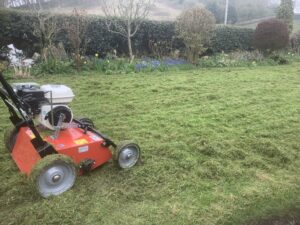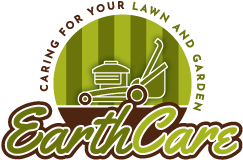Earth Care
Scarification
Maximise your lawn's growth
Lawn Scarification
Scarification
Lawn Scarification is a process of removing surface thatch and moss from a lawn. Thatch on the surface of a lawn is very common and forms naturally, the problems start when there is too much. This results in reduced airflow across the surface, preventing moisture and nutrients reaching the roots of the grass.
This in turn weakens the grass plants and makes them more prone to the effects of drought and diseases. When there is too much thatch it is important that it is removed
This can be done by hand with a spring tine rake, but if you have quite a big area this is very time consuming. We use a machine to speed up the lawn scarification process.
It is quite a harsh process on the grass plants, but once completed the grass recovers quite quickly when we add fertiliser, and water if required.
Depending on the level of the issue with your lawn, two or maybe three passes will be required, this brings out a lot of thatch, moss etc.
Additionally, after scarification it worthwhile overseeding, and top dressing. This will help thicken your lawn by adding additional seed, the covering with a fine compost/soil mix.
Overseeding
Overseeding is carried out by spreading grass seed over the scarified area, then using a drag mat or lute they are driven into the base of the grass to germinate.
Top Dressing
Top Dressing has a huge impact on the recovery of your lawn. Basically a thin layer of compost/soil mix is spread. This covers seeds to aid germination but also covers the exposed grass roots, to help them sprout. Additionally, it gives off a slow release fertiliser as the compost breaks down. The dressing also helps to even out any humps and hollows in the lawn, so levelling out the surface.
More Information about Lawn Scarification
 Lawn Scarification
Lawn Scarification
Get In Touch
Want to find out more about our services or to find out how we can help your garden, contact us on the details below.
What is thatch?
In simple terms, thatch is a layer of organic matter that is contained within your lawn. Thatch is usually made up of living stems, roots, leaves as well as grass cuttings.
Thatch will most likely form a thin layer over your lawn. This can be beneficial as it helps to insulate the lawn and help the lawn to be resistant from the harsher weather that we have from time to time. However, when thatch exceeds a certain limit it can deprive the grass root system of oxygen, nutrients, and water.
When a thick layer of thatch has appeared, your lawn may find it tougher to drain away excess water and nutrients. It is easy to notice if your lawn has a thick layer of thatch as it will become spongy underfoot.
What to expect
At Earth Care, we are experienced professionals with many years of experience in lawn care and associated methods.
As part of our first visit to your home, we will assess the lawn and put together a treatment plan to get your lawn back to its original state.
From this assessment we are able to understand the level of thatch that you have, and how in-depth the scarification process will need to be.
